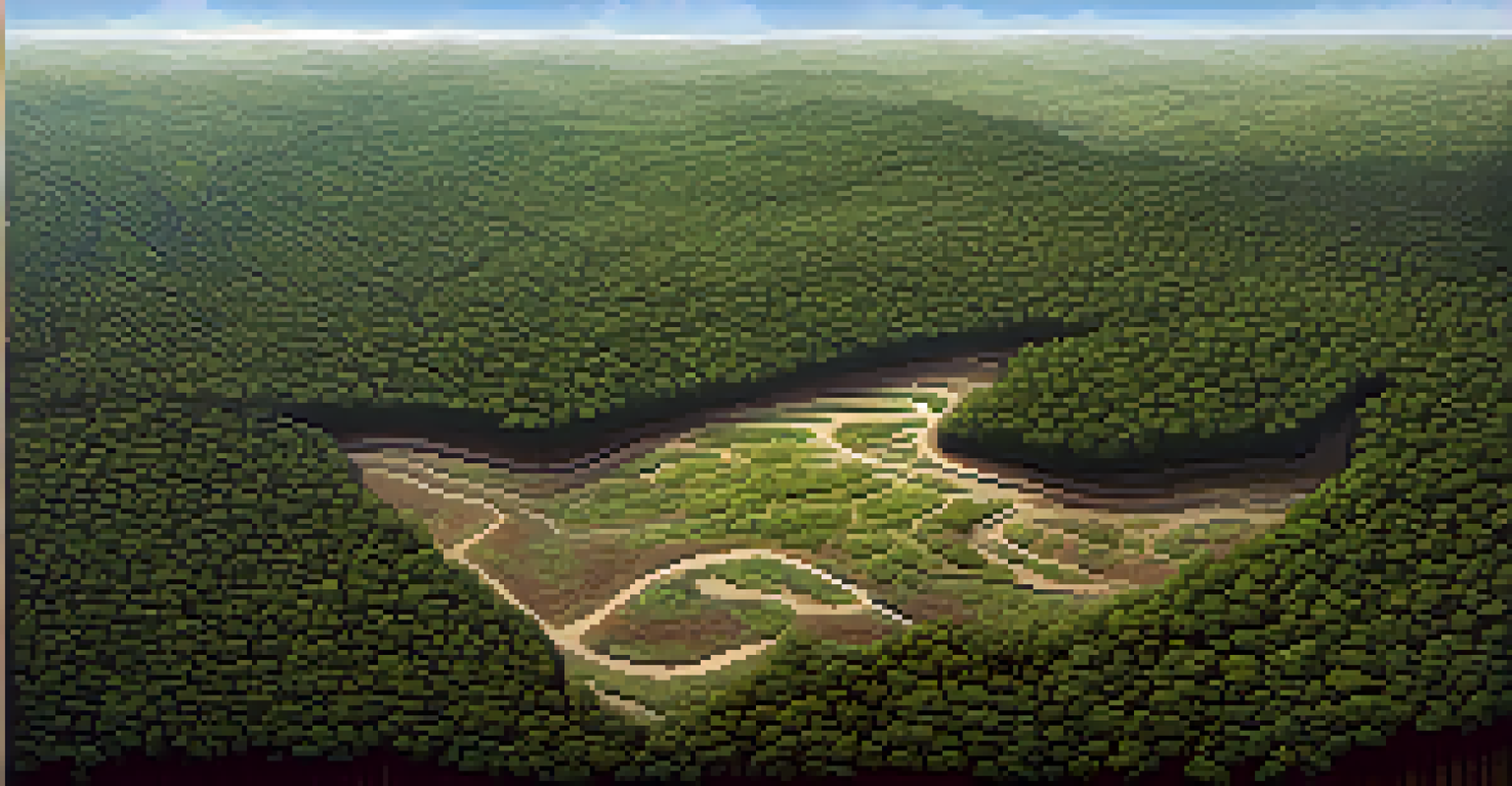The Role of Deforestation in Declining Plant Diversity Today

Understanding Deforestation and Its Causes
Deforestation refers to the clearing of forests for various purposes, such as agriculture, urban development, and logging. This practice is driven by the increasing demand for land and resources, often fueled by a growing population and consumerism. While some deforestation is inevitable for development, the scale at which it occurs today is alarming and unsustainable.
The clearest way into the Universe is through a forest wilderness.
The primary causes of deforestation include agricultural expansion, logging operations, and infrastructure development. For instance, palm oil production has led to massive forest clearance in Southeast Asia, significantly impacting local ecosystems. Understanding these causes is crucial to addressing the root of the problem and finding sustainable solutions.
Moreover, deforestation is often compounded by socio-economic factors, such as poverty and lack of education. Communities may rely on forest resources for their livelihoods, leading to unsustainable practices that further exacerbate the issue. By addressing these underlying factors, we can work towards reducing deforestation and preserving plant diversity.
The Importance of Plant Diversity
Plant diversity is essential for maintaining healthy ecosystems. Each species plays a unique role, contributing to soil health, water cycles, and the overall resilience of an environment. For instance, diverse plant life can help prevent soil erosion, promote carbon sequestration, and support a range of animal species.

Moreover, diverse plant communities are crucial for human well-being. Many medicines, food sources, and materials come from plants, and a decline in plant diversity threatens these resources. Consider how many of our everyday products, from aspirin to cotton shirts, originate from various plant species; their loss could drastically affect our quality of life.
Deforestation Threatens Ecosystems
The clearing of forests for agriculture and urban development leads to significant loss of plant species and disrupts ecological balance.
Additionally, plant diversity supports climate regulation by absorbing carbon dioxide and releasing oxygen. This process helps mitigate climate change impacts, making the preservation of diverse plant life not just an ecological concern but a global necessity. Protecting plant diversity is, therefore, vital for both nature and humanity.
How Deforestation Affects Plant Diversity
When forests are cleared, the immediate impact is the loss of countless plant species that may not be found anywhere else. This loss can lead to a decline in genetic diversity, making ecosystems more vulnerable to diseases and climate change. For example, monoculture practices, where a single crop dominates, can strip the land of its natural resilience.
In every walk with nature, one receives far more than he seeks.
Furthermore, deforestation disrupts the intricate relationships between plants and other organisms, such as pollinators and seed dispersers. Without these relationships, plants struggle to reproduce and thrive, leading to further declines in diversity. Think of it like a complex web; if one thread is pulled, the entire structure can begin to unravel.
The fragmentation of habitats due to deforestation also makes it challenging for plants to migrate in response to climate shifts. Many species rely on specific conditions to flourish, and as their habitats shrink or change, they may not survive. This ongoing cycle of decline is a significant concern for conservationists and ecologists alike.
The Global Impact of Declining Plant Diversity
The decline in plant diversity has far-reaching implications, not just locally but globally. As ecosystems collapse, the services they provide—such as clean water, fertile soil, and climate regulation—are compromised. This can lead to food insecurity and increased vulnerability to natural disasters, disproportionately affecting marginalized communities.
Moreover, the loss of plant diversity impacts the global economy. Industries such as agriculture, pharmaceuticals, and tourism rely on biodiversity for their operations. For instance, a decrease in plant species can limit the development of new medicines, stalling progress in healthcare and innovation.
Plant Diversity Supports Humanity
A decline in plant diversity jeopardizes essential resources for food, medicine, and climate regulation, affecting both ecosystems and human well-being.
In a world where everything is interconnected, the decline in plant diversity can create a ripple effect that touches every aspect of life. From local economies to global markets, the consequences of deforestation are profound and warrant urgent attention.
Conservation Efforts to Combat Deforestation
Many organizations and governments have recognized the urgent need to combat deforestation and protect plant diversity. Conservation efforts range from establishing protected areas to promoting sustainable land-use practices. These initiatives aim to balance the needs of communities with the necessity of preserving ecosystems.
One effective approach is reforestation, which involves planting trees in deforested areas to restore habitats. For example, projects in Brazil and Indonesia have successfully reintroduced native species, helping to revive local ecosystems. These efforts not only benefit the environment but also create jobs and enhance community resilience.
Additionally, raising awareness about the importance of plant diversity can drive change at both individual and collective levels. By encouraging sustainable consumer behaviors, such as supporting eco-friendly products, we can contribute to the preservation of our planet's biodiversity. Every small action counts in the fight against deforestation.
The Role of Technology in Conservation
Technology plays a pivotal role in modern conservation efforts, offering innovative solutions to combat deforestation and protect plant diversity. Satellite imagery and drones allow scientists to monitor forest cover and track changes over time, providing valuable data for informed decision-making. This technology helps identify critical areas needing protection and restoration.
Moreover, advancements in genetic research enable the preservation of plant diversity through seed banks and biobanking. By storing seeds from various plant species, we can safeguard genetic diversity and ensure the availability of these resources for future generations. This proactive approach helps mitigate the risks associated with climate change and habitat loss.
Conservation Efforts Are Essential
Initiatives like reforestation and sustainable practices are crucial for combating deforestation and preserving plant diversity for future generations.
Additionally, social media and digital platforms have become powerful tools for raising awareness and mobilizing action. Campaigns that highlight the importance of plant diversity can inspire individuals and communities to engage in conservation efforts. Technology, therefore, is not just a tool but a catalyst for change in the fight against deforestation.
What Individuals Can Do to Help
While large-scale efforts are essential, individual actions can also make a significant difference in combating deforestation and protecting plant diversity. Simple steps, such as reducing paper usage, supporting sustainable brands, and participating in local conservation initiatives, can collectively lead to meaningful change. Every action counts, no matter how small.
Additionally, educating oneself and others about the importance of plant diversity can amplify efforts. Sharing information on social media, discussing the issue with friends and family, or volunteering for environmental organizations can help raise awareness and drive further action. The more people know, the more likely they are to care and contribute.

Ultimately, fostering a connection with nature can inspire individuals to take action. Whether it’s planting a tree, starting a garden, or simply spending time outdoors, these experiences deepen our appreciation for the environment and motivate us to protect it. Together, we can be stewards of the earth and champions of plant diversity.